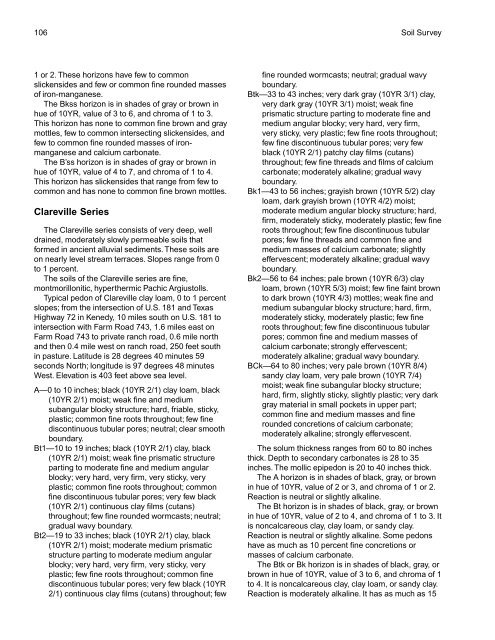Soil Survey of Karnes County, Texas - Soil Data Mart - US ...
Soil Survey of Karnes County, Texas - Soil Data Mart - US ...
Soil Survey of Karnes County, Texas - Soil Data Mart - US ...
You also want an ePaper? Increase the reach of your titles
YUMPU automatically turns print PDFs into web optimized ePapers that Google loves.
106 <strong>Soil</strong> <strong>Survey</strong><br />
1 or 2. These horizons have few to common<br />
slickensides and few or common fine rounded masses<br />
<strong>of</strong> iron-manganese.<br />
The Bkss horizon is in shades <strong>of</strong> gray or brown in<br />
hue <strong>of</strong> 10YR, value <strong>of</strong> 3 to 6, and chroma <strong>of</strong> 1 to 3.<br />
This horizon has none to common fine brown and gray<br />
mottles, few to common intersecting slickensides, and<br />
few to common fine rounded masses <strong>of</strong> ironmanganese<br />
and calcium carbonate.<br />
The B’ss horizon is in shades <strong>of</strong> gray or brown in<br />
hue <strong>of</strong> 10YR, value <strong>of</strong> 4 to 7, and chroma <strong>of</strong> 1 to 4.<br />
This horizon has slickensides that range from few to<br />
common and has none to common fine brown mottles.<br />
Clareville Series<br />
The Clareville series consists <strong>of</strong> very deep, well<br />
drained, moderately slowly permeable soils that<br />
formed in ancient alluvial sediments. These soils are<br />
on nearly level stream terraces. Slopes range from 0<br />
to 1 percent.<br />
The soils <strong>of</strong> the Clareville series are fine,<br />
montmorillonitic, hyperthermic Pachic Argiustolls.<br />
Typical pedon <strong>of</strong> Clareville clay loam, 0 to 1 percent<br />
slopes; from the intersection <strong>of</strong> U.S. 181 and <strong>Texas</strong><br />
Highway 72 in Kenedy, 10 miles south on U.S. 181 to<br />
intersection with Farm Road 743, 1.6 miles east on<br />
Farm Road 743 to private ranch road, 0.6 mile north<br />
and then 0.4 mile west on ranch road, 250 feet south<br />
in pasture. Latitude is 28 degrees 40 minutes 59<br />
seconds North; longitude is 97 degrees 48 minutes<br />
West. Elevation is 403 feet above sea level.<br />
A—0 to 10 inches; black (10YR 2/1) clay loam, black<br />
(10YR 2/1) moist; weak fine and medium<br />
subangular blocky structure; hard, friable, sticky,<br />
plastic; common fine roots throughout; few fine<br />
discontinuous tubular pores; neutral; clear smooth<br />
boundary.<br />
Bt1—10 to 19 inches; black (10YR 2/1) clay, black<br />
(10YR 2/1) moist; weak fine prismatic structure<br />
parting to moderate fine and medium angular<br />
blocky; very hard, very firm, very sticky, very<br />
plastic; common fine roots throughout; common<br />
fine discontinuous tubular pores; very few black<br />
(10YR 2/1) continuous clay films (cutans)<br />
throughout; few fine rounded wormcasts; neutral;<br />
gradual wavy boundary.<br />
Bt2—19 to 33 inches; black (10YR 2/1) clay, black<br />
(10YR 2/1) moist; moderate medium prismatic<br />
structure parting to moderate medium angular<br />
blocky; very hard, very firm, very sticky, very<br />
plastic; few fine roots throughout; common fine<br />
discontinuous tubular pores; very few black (10YR<br />
2/1) continuous clay films (cutans) throughout; few<br />
fine rounded wormcasts; neutral; gradual wavy<br />
boundary.<br />
Btk—33 to 43 inches; very dark gray (10YR 3/1) clay,<br />
very dark gray (10YR 3/1) moist; weak fine<br />
prismatic structure parting to moderate fine and<br />
medium angular blocky; very hard, very firm,<br />
very sticky, very plastic; few fine roots throughout;<br />
few fine discontinuous tubular pores; very few<br />
black (10YR 2/1) patchy clay films (cutans)<br />
throughout; few fine threads and films <strong>of</strong> calcium<br />
carbonate; moderately alkaline; gradual wavy<br />
boundary.<br />
Bk1—43 to 56 inches; grayish brown (10YR 5/2) clay<br />
loam, dark grayish brown (10YR 4/2) moist;<br />
moderate medium angular blocky structure; hard,<br />
firm, moderately sticky, moderately plastic; few fine<br />
roots throughout; few fine discontinuous tubular<br />
pores; few fine threads and common fine and<br />
medium masses <strong>of</strong> calcium carbonate; slightly<br />
effervescent; moderately alkaline; gradual wavy<br />
boundary.<br />
Bk2—56 to 64 inches; pale brown (10YR 6/3) clay<br />
loam, brown (10YR 5/3) moist; few fine faint brown<br />
to dark brown (10YR 4/3) mottles; weak fine and<br />
medium subangular blocky structure; hard, firm,<br />
moderately sticky, moderately plastic; few fine<br />
roots throughout; few fine discontinuous tubular<br />
pores; common fine and medium masses <strong>of</strong><br />
calcium carbonate; strongly effervescent;<br />
moderately alkaline; gradual wavy boundary.<br />
BCk—64 to 80 inches; very pale brown (10YR 8/4)<br />
sandy clay loam, very pale brown (10YR 7/4)<br />
moist; weak fine subangular blocky structure;<br />
hard, firm, slightly sticky, slightly plastic; very dark<br />
gray material in small pockets in upper part;<br />
common fine and medium masses and fine<br />
rounded concretions <strong>of</strong> calcium carbonate;<br />
moderately alkaline; strongly effervescent.<br />
The solum thickness ranges from 60 to 80 inches<br />
thick. Depth to secondary carbonates is 28 to 35<br />
inches. The mollic epipedon is 20 to 40 inches thick.<br />
The A horizon is in shades <strong>of</strong> black, gray, or brown<br />
in hue <strong>of</strong> 10YR, value <strong>of</strong> 2 or 3, and chroma <strong>of</strong> 1 or 2.<br />
Reaction is neutral or slightly alkaline.<br />
The Bt horizon is in shades <strong>of</strong> black, gray, or brown<br />
in hue <strong>of</strong> 10YR, value <strong>of</strong> 2 to 4, and chroma <strong>of</strong> 1 to 3. It<br />
is noncalcareous clay, clay loam, or sandy clay.<br />
Reaction is neutral or slightly alkaline. Some pedons<br />
have as much as 10 percent fine concretions or<br />
masses <strong>of</strong> calcium carbonate.<br />
The Btk or Bk horizon is in shades <strong>of</strong> black, gray, or<br />
brown in hue <strong>of</strong> 10YR, value <strong>of</strong> 3 to 6, and chroma <strong>of</strong> 1<br />
to 4. It is noncalcareous clay, clay loam, or sandy clay.<br />
Reaction is moderately alkaline. It has as much as 15
















